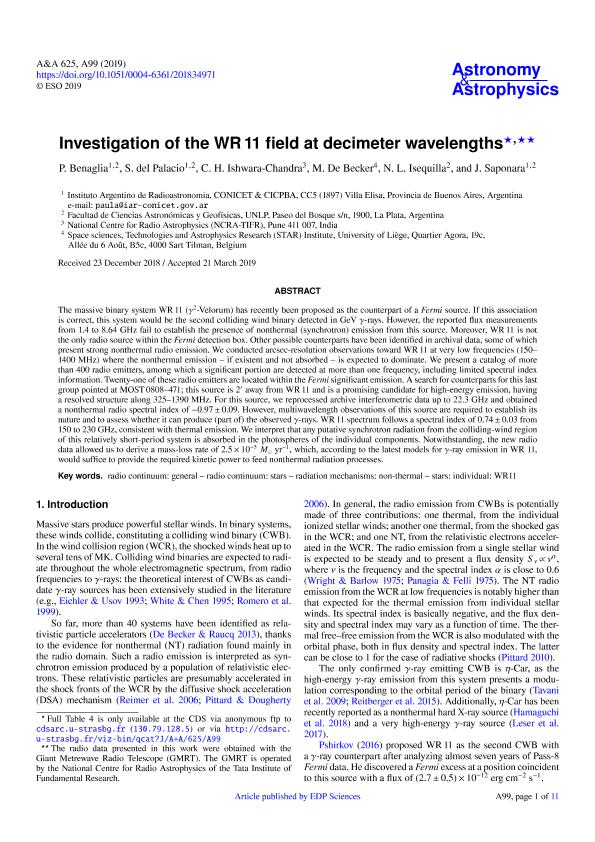Artículo
Investigation of the WR 11 field at decimeter wavelengths
Benaglia, Paula ; del Palacio, Santiago
; del Palacio, Santiago ; Ishwara-Chandra, C. H.; De Becker, M.; Isequilla, Natacha Laura
; Ishwara-Chandra, C. H.; De Becker, M.; Isequilla, Natacha Laura ; Saponara, Juliana
; Saponara, Juliana
 ; del Palacio, Santiago
; del Palacio, Santiago ; Ishwara-Chandra, C. H.; De Becker, M.; Isequilla, Natacha Laura
; Ishwara-Chandra, C. H.; De Becker, M.; Isequilla, Natacha Laura ; Saponara, Juliana
; Saponara, Juliana
Fecha de publicación:
05/2019
Editorial:
EDP Sciences
Revista:
Astronomy and Astrophysics
ISSN:
0004-6361
Idioma:
Inglés
Tipo de recurso:
Artículo publicado
Clasificación temática:
Resumen
The massive binary system WR 11 (γ2-Velorum) has recently been proposed as the counterpart of a Fermi source. If this association is correct, this system would be the second colliding wind binary detected in GeV γ-rays. However, the reported flux measurements from 1.4 to 8.64 GHz fail to establish the presence of nonthermal (synchrotron) emission from this source. Moreover, WR 11 is not the only radio source within the Fermi detection box. Other possible counterparts have been identified in archival data, some of which present strong nonthermal radio emission. We conducted arcsec-resolution observations toward WR 11 at very low frequencies (150-1400 MHz) where the nonthermal emission - if existent and not absorbed - is expected to dominate. We present a catalog of more than 400 radio emitters, among which a significant portion are detected at more than one frequency, including limited spectral index information. Twenty-one of these radio emitters are located within the Fermi significant emission. A search for counterparts for this last group pointed at MOST 0808-471; this source is 2´ away from WR 11 and is a promising candidate for high-energy emission, having a resolved structure along 325-1390 MHz. For this source, we reprocessed archive interferometric data up to 22.3 GHz and obtained a nonthermal radio spectral index of - 0.97 ± 0.09. However, multiwavelength observations of this source are required to establish its nature and to assess whether it can produce (part of) the observed γ-rays. WR 11 spectrum follows a spectral index of 0.74 ± 0.03 from 150 to 230 GHz, consistent with thermal emission. We interpret that any putative synchrotron radiation from the colliding-wind region of this relatively short-period system is absorbed in the photospheres of the individual components. Notwithstanding, the new radio data allowed us to derive a mass-loss rate of 2.5 × 10-5 M☉ yr-1, which, according to the latest models for γ-ray emission in WR 11, would suffice to provide the required kinetic power to feed nonthermal radiation processes.Full Table 4 is only available at the CDS via anonymous ftp to http://cdsarc.u-strasbg.fr (ftp://130.79.128.5) or via http://cdsarc.u-strasbg.fr/viz-bin/qcat?J/A+A/625/A99The radio data presented in this work were obtained with the Giant Metrewave Radio Telescope (GMRT). The GMRT is operated by the National Centre for Radio Astrophysics of the Tata Institute of Fundamental Research.
Archivos asociados
Licencia
Identificadores
Colecciones
Articulos(IAR)
Articulos de INST.ARG.DE RADIOASTRONOMIA (I)
Articulos de INST.ARG.DE RADIOASTRONOMIA (I)
Citación
Benaglia, Paula; del Palacio, Santiago; Ishwara-Chandra, C. H.; De Becker, M.; Isequilla, Natacha Laura; et al.; Investigation of the WR 11 field at decimeter wavelengths; EDP Sciences; Astronomy and Astrophysics; 625; 5-2019; 99-109
Compartir
Altmétricas



